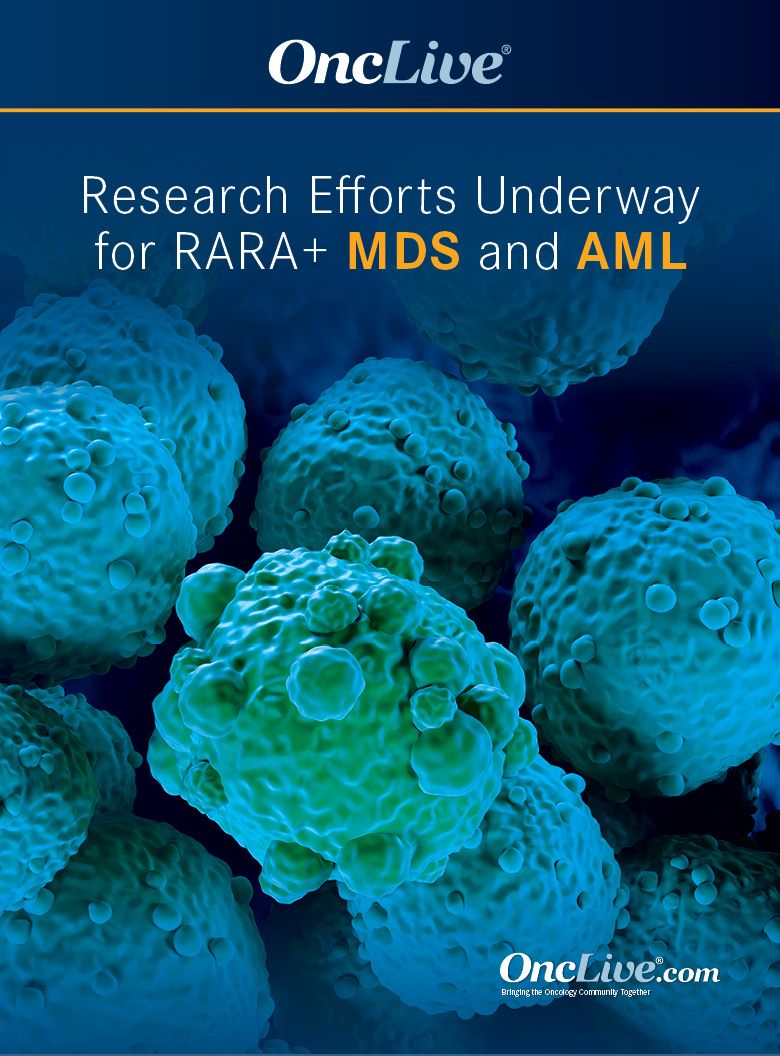Tamibarotene Highlights Novel Treatment Strategy in RARA+ AML
Retinoic acid receptor α, a gene overexpressed in approximately 30% of unfit patients with newly diagnosed acute myeloid leukemia, has emerged as a potential therapeutic target.
Afaf E. Osman, MD

Retinoic acid receptor α (RARA), a gene overexpressed in approximately 30% of unfit patients with newly diagnosed acute myeloid leukemia (AML), has emerged as a potential therapeutic target. The overexpression of RARA in AML has been correlated with resistance to the BCL2 inhibitorvenetoclax (Venclexta), a traditional treatment option used as a part of combination therapies in this patient population.1
“There is a subset of patients with AML and MDS [myelodysplastic syndrome] who are characterized by an increased expression of RARA,” Afaf E. Osman, MD, an assistant professor at the University of Utah, Huntsman Cancer Institute, the University of Utah Health, in Salt Lake City said in an interview with OncologyLive®. “It was recognized in preclinical work that patients who have increased expression of this gene also have unique disease characteristics and have decreased response to the conventional therapies. A lot of these patients have comorbidities [and] are not eligible for intensive chemotherapy. That makes it a challenging population to develop drugs for [as] you have to balance out the toxicities vs the improvement in survival.”
The standard of care in the first line for patients with newly diagnosed AML unfit for intensive therapy is venetoclax plus the hypomethylating agent azacitidine (Vidaza). The combination demonstrated survival benefits in this patient population in the phase 3 VIALE-A trial (NCT02993523), in which the median overall survival (OS) was 14.7 months (95% CI, 11.9-18.7) for venetoclax plus azacitidine (n = 286) compared with 9.6 months (95% CI, 7.4-12.7) for patients treated with azacitidine monotherapy (n = 145; HR, 0.66; 95% CI, 0.52-0.85; P < .001). The complete remission (CR) rate was higher with the combination, 36.7% vs 17.9%, respectively.2
However, treatment with venetoclax plus azacitidine resulted in significant hematologic toxicities. Most of the population in the experimental arm (83%) experienced a hematologic adverse effect (AE) compared with 69% of the control group. Hematologic AEs of grade 3 or higher occurred in 82% and 68% of patients, respectively. Dose interruptions and reductions were primarily due to febrile neutropenia (20%), neutropenia (19%), and thrombocytopenia (10%) among patients treated with the combination.
“Despite the encouraging initial responses [with venetoclax], a lot of patients lose their responses,” Osman explained. “[When] combining it with other drugs that target other mechanisms, you might be able to get more patients into longer responses and overcome some of these other resistance mechanisms. The problem is [AEs] and toxicity, myelosuppression in particular. Venetoclax especially is very myelotoxic.”
To address the clear unmet need in the sizable subset of patients with RARA-positive AML or MDS, and to attempt to offer a less toxic regimen than the current standard, investigators developed the novel agent tamibarotene (formerly SY-1425), a RARA agonist.3
Tamibarotene Plus Azacitidine Validates RARA-Targeted Approach
Tamibarotene demonstrated early efficacy in combination with azacitidine in patients with treatment-naïve, non-acute promyelocytic leukemia AML who are unfit for intensive induction chemotherapy as part of the phase 2 SY-1425-201 trial (NCT02807558). The trial enrolled patients who are RARA-positive (n=22) as well as RARA-negative (n=29).1
Patients were screened for RARA status using a peripheral blood-based test, then were treated with azacitidine at a dose of 75 mg/m2 intravenously or subcutaneously on days 1 through 7 of a 28-day cycle. After treatment with azacitidine, patients received oral tamibarotene 6 mg/m2 orally divided into a twice daily dosing on days 8 through 28.
The primary end point of the trial is overall response rate (ORR) per International Working Group criteria. Secondary end points consist of composite CR rate, time to response, duration of response, transfusion independence, OS, safety and tolerability, and the molecular and cytogenic characteristics associated with response.
Updated results from the trial through May 27, 2020, presented at the 62nd American Society of Hematology Annual Meeting and Exposition showed that tamibarotene plus azacitidine was more effective in the RARA-positive cohort. Efficacy-evaluable RARA-positive patients (n =18) experienced an ORR of 67%, including 9 CRs and 2 complete remissions with incomplete count recovery (CRis). In comparison, RARA-negative patients who were evaluable for efficacy (n=28) achieved an ORR of 39% with 6 CRs and 2 CRis. Notably, the responses seen in the RARA-positive population did not appear to be correlated with any specific mutation or cytogenic risk.1
Patients in with RARA-positive disease also experienced a shorter time to initial CR compared with those who were RARA-negative, at a median of 1.2 and 2.9 months, respectively. Additionally, patients who achieved CRs in the RARA-positive arm also had complete molecular or cytogenetic remissions at a rate of 89%. Transfusion independence was observed in 72% of patients who were RARA-positive.
In terms of safety, investigators noted that the tolerability profile of tamibarotene plus azacitidine was consistent with that of azacitidine monotherapy and tamibarotene monotherapy.
The most common AEs of any grade in the total population were decreased appetite (41%), hypertriglyceridemia (41%), nausea (39%), constipation (39%), and fatigue (35%). The most frequently occurring serious AEs consisted of febrile neutropenia (27%), pyrexia (12%), and pneumonia (12%). Most nonhematologic AEs were low grade and reversible.1
Hematologic AEs seen in the study were generally grade 3 or higher. Febrile neutropenia (33%), thrombocytopenia (24%), and anemia (20%) of at least grade 3 were all reported.
Investigators concluded that tamibarotene plus azacitidine displayed potential as a novel targeted regimen for patients with RARA-positive AML who are unfit for intensive treatment and that the continued development of the regimen is justified.
“The results are very encouraging, especially in patients who had expression or increased expression of RARA—[they displayed] really high overall response rates,” Osman said. “The toxicity profile was comparable to the single agents, and there does not seem to be increased myelosuppression from the combination. A [notable] thing about the trials with this drug is that it is biomarker-based approach. There is a lot of that in AML, but not as much in MDS specifically. That makes it really exciting.”
Details of the SELECT-AML-1 Trial
The phase 2 SELECT-AML-1 trial (NCT04905407) will evaluate the triplet treatment regimen of tamibarotene, venetoclax, and azacitidine in patients with newly diagnosed, RARA-positive AML who are unlikely to tolerated standard chemotherapy. The trial will enroll approximately 95 patients and will be divided into 3 parts.3
In part 1, the combination of tamibarotene, venetoclax, and azacitidine will be evaluated for safety, tolerability, and pharmacokinetics and the part 2 regimen and dose will be determined. Oral tamibarotene will be administered at a dose of 6 mg twice daily on days 8 through 28 of each 28-day cycle. Intravenous or subcutaneous azacitidine 75 mg/m2 will be given daily on days 1 through 7 of each cycle, with alternative dosing on days 1 through 5, 8, and 9 permitted. Patients will receive venetoclax on days 1 through 28 per the standard of care of 100 mg on day 1, 200 mg on day 2, and 400 mg on day 3 and beyond.
Part 2 of SELECT-AML-1 will randomize patients 1:1 to be treated with either the triplet regimen at the dose determined in part 1 or venetoclax plus azacitidine. Patients who receive the venetoclax plus azacitidine combination and have disease progression, relapse after an initial CR or CRi, or fail on treatment will have tamibarotene added to their treatment regimen in part 3.
The primary end point in part 1 is the number of patients who experience an AE. In part 2, the primary end point is CR/CRi rate. Secondary end points include ORR and plasma concentration of tamibarotene in part 1, and CR rate and duration of CR in part 2. The estimated completion date of the study is December 2023.
“This is a unique population with a lower tolerance to the toxicities of some of the newer agents,” Osman said. “We need drugs that are well tolerated, [produce] less myelosuppression, and are easier to administer. In this population, quality of life is important, and a lot of the drugs that are intravenous or have harder-to-administer schedules produce a burden on these patients. It would be nice to have oral options as well.”
References
- De Botton S, Cluzeau T, Vigil CE, et al. SY-1425, a potent and selective RARα agonist, in combination with azacitidine demonstrates a high complete response rate and a rapid onset of response in RARA-positive newly diagnosed unfit acute myeloid leukemia. Blood. 2020;136(suppl 1):4-5. doi:10.1182/blood-2020-134600
- DiNardo CD, Jonas BA, Pullarkat V, et al. Azacitidine and venetoclax in previously untreated acute myeloid leukemia. N Engl J Med. 2020;383(7):617-629. doi:10.1056/NEJMoa2012971
- Tamibarotene plus venetoclax/azacitidine in participants with newly diagnosed AML. ClinicalTrials.gov. Updated April 6, 2022. Accessed June 23, 2022. https://clinicaltrials.gov/ct2/show/NCT04905407




